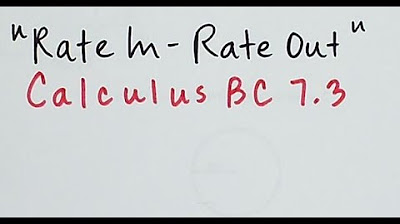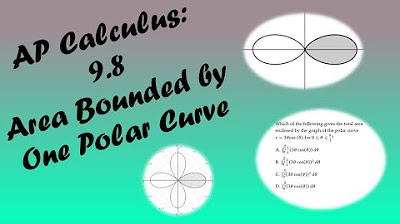Calculus of Polar Curves: Distance Between Curves
TLDRThis video tutorial delves into polar calculus, focusing on calculating the distance between two polar curves at a specific theta value, the rate of change of this distance, and the average distance over an interval. It also covers an area problem involving the region bounded by the curves. The instructor provides a step-by-step explanation, including the use of derivatives and integrals, and references specific AP exam questions for context. The video is aimed at helping students understand these concepts, especially those who found them challenging.
Takeaways
- 📏 The video covers topics related to polar coordinates in calculus, specifically focusing on distance between polar curves, rate of change of distance, and average distance.
- 📐 The distance between two polar curves R1 and R2 at a specific value of theta (K) is given by D(K) = R1(K) - R2(K).
- 🚀 The rate of change of the distance between the two curves is found by taking the derivative of the distance function, D'(K) = R1'(K) - R2'(K).
- 📊 The average distance between the two curves over an interval [A, B] is calculated using the integral of the distance function over the interval, divided by the length of the interval.
- 📅 The method described assumes that R1 is always greater than R2 within the given interval. If the order changes, adjustments like using absolute values may be necessary.
- 📝 Examples from the AP BC exam (2017 number 2 Part C and 2014 number 2 Part C) are mentioned as motivation for the video.
- 📉 The video includes a specific problem where R1 = theta + 5sin(theta)cos(theta) and R2 = (3/5)theta^2, with theta ranging from 0 to pi/2.
- 🔢 To find the rate of change of distance at theta = pi/3, the derivatives of R1 and R2 are evaluated at pi/3 using a calculator, resulting in approximately -2.757.
- 📈 The average distance between R1 and R2 over the interval from 0 to pi/2 is calculated using a calculator to evaluate the integral, resulting in approximately 1.883.
- 🧮 The area of the region bounded by the two curves is found by integrating the difference of the squares of R1 and R2, multiplied by 1/2, resulting in approximately 4.720.
Q & A
What is the primary topic discussed in the video?
-The video primarily discusses the concepts of distance between polar curves at a specific value of theta, the rate of change of distance, average distance, and an area problem related to polar curves.
How is the distance between two polar curves defined in the video?
-The distance between two polar curves, R1 and R2, at a specific theta value K is defined as D(K) = R1(K) - R2(K), where R1 is the larger curve and R2 is the smaller one.
What is the formula for the rate of change of distance between two polar curves?
-The rate of change of distance, denoted as D'(K), is given by the derivative of the distance function, which is R1'(K) - R2'(K), where R1' and R2' are the derivatives of R1 and R2 evaluated at K.
How is the average distance between two polar curves calculated?
-The average distance between two polar curves R1 and R2 over an interval from A to B is calculated by integrating the distance function (R1 - R2) with respect to theta from A to B and then dividing by the interval length (B - A).
What are the specific polar equations given in the video for R1 and R2?
-In the video, R1 is given as theta + 5 * sin(theta) * cos(theta) and R2 is given as 3/5 * theta squared.
What is the theta interval considered in the video for the polar equations?
-The theta interval considered in the video is from 0 to π/2.
How does the video demonstrate the calculation of the rate of change of distance between R1 and R2 at theta equals π/3?
-The video demonstrates this by calculating the derivative of the distance function (R1 - R2) at theta equals π/3, which involves finding R1' and R2' and evaluating them at π/3.
What is the approximate value of the rate of change of distance between R1 and R2 at theta equals π/3 as given in the video?
-The approximate value of the rate of change of distance at theta equals π/3 is -2.757.
How is the average distance between R1 and R2 over the interval from 0 to π/2 calculated in the video?
-The average distance is calculated by integrating the distance function (R1 - R2) from 0 to π/2 and then dividing by the interval length (π/2 - 0), which results in an approximate value of 1.883.
What is the additional area problem discussed in the video, and how is it solved?
-The additional area problem discussed in the video is finding the area between the two polar curves R1 and R2 over the interval from 0 to π/2. It is solved by integrating the difference of the squares of the two functions (R1^2 - R2^2) with respect to theta and multiplying by 1/2, resulting in an approximate area of 4.720.
Outlines
📚 Calculus and Polar Curves Distance Analysis
This paragraph introduces the topic of the video, which is to discuss the distance between polar curves in calculus, specifically focusing on the distance at a specific value of theta, the rate of change of this distance, and the average distance. It also mentions an area problem related to the polar curves. The scenario involves two polar functions, R1 and R2, with R1 being greater than R2 between two theta values, a and B. The distance between the curves at any theta value K is defined as D(K) = R1(K) - R2(K). The rate of change of this distance is the derivative of D(K), which is R1'(K) - R2'(K). The average distance is calculated by integrating the distance function over the interval from A to B and dividing by the length of the interval. The paragraph also references past AP exam questions that motivated the creation of this video and provides an example with specific polar functions and a theta interval.
📈 Calculating the Rate of Change and Average Distance
This paragraph continues the discussion by providing a step-by-step approach to calculate the rate of change of the distance between two polar curves at a specific theta value, using the given functions R1(theta) = theta + 5sin(theta)cos(theta) and R2(theta) = 3/5theta^2, with theta ranging from 0 to PI/2. It explains how to find the derivative of the distance function at theta = PI/3 and uses a calculator to find the approximate value of this rate of change. The paragraph also explains how to calculate the average distance between the two curves over the entire interval, again using a calculator to find the integral of the difference between the two functions and dividing by the interval length. Finally, it introduces a bonus problem of finding the area bounded by the two curves, emphasizing the importance of not forgetting to multiply by 1/2 when calculating the area between polar curves.
Mindmap
Keywords
💡Polar Coordinates
💡Polar Curves
💡Distance
💡Rate of Change
💡Average Distance
💡Derivative
💡Integral
💡Area
💡Theta (θ)
💡R1 and R2
Highlights
Introduction to the topic of calculating distances between polar curves at specific theta values.
Explanation of the formula for the distance between two polar curves, R1 and R2, at a specific theta value.
Derivation of the rate of change of distance using the derivatives of R1 and R2.
Calculation of the average distance between two polar curves over an interval.
Emphasis on the importance of R1 being greater than R2 for the calculations.
Examples from AP BC exam 2017 and 2014 that motivated the creation of this video.
Presentation of two specific polar functions, R1 and R2, to be analyzed.
Graphical representation of the polar curves provided for reference.
Method to find the rate of change of distance between the curves at theta equals PI/3.
Use of a calculator to find the derivative of the distance function at a specific point.
Approximation of the rate of change of distance as negative two point seven five seven.
Process to calculate the average distance between the curves over the interval from 0 to PI/2.
Integration of the difference between R1 and R2 to find the average distance.
Approximation of the average distance as one point eight eight three.
Introduction to a bonus area problem involving the calculation of the area between the two polar curves.
Common mistake reminder to multiply by 1/2 when calculating the area between polar curves.
Calculation of the area by integrating the difference of the squared functions of R1 and R2.
Approximation of the area as four point seven two zero.
Conclusion summarizing the methods for distance, rate of change, average distance, and area calculations.
Transcripts
Browse More Related Video

Polar, Parametric, Vector Multiple Choice Practice for Calc BC (Part 3)

Polar, Parametric, Vector Multiple Choice Practice for Calc BC (Part 4)

Rate In - Rate Out

7 | FRQ (No Calculator) | Practice Sessions | AP Calculus AB

AP Calculus BC Lesson 9.8

AP Calculus AB 2012 Multiple Choice (calculator) - Questions 76 - 92
5.0 / 5 (0 votes)
Thanks for rating: